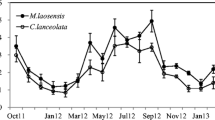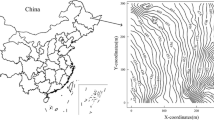Abstract
For secondary forests, the major forest resources in China (accounting for more than 50% of the national total), soil respiration (R S) and the relationship between R S and various biotic/abiotic factors are poorly understood. The objectives of the present study were to examine seasonal variations in soil respiration during the growing season, and to explore the factors affecting the variation in soil respiration rates for three forest types (Mongolian oak, Manchurian walnut and mixed forests) of temperate secondary forest in Northeast China. The results showed that (1) the maximum total R S rate occurred in July, following a bell-shaped curve with season, (2) for all forest types, the total R S was significantly influenced by soil temperature (P < 0.01), and did not significantly correlate with soil moisture, (3) compared with fine root biomass, coarse root biomass was more closely related with the root respiration in mixed forest (R 2 = 0.711, P = 0.017) and in Manchurian walnut forest (R 2 = 0.768, P = 0.010), and (4) microbial biomass carbon (MBC) and nitrogen were significantly correlated with heterotrophic R S in Mongolian oak forest (R 2 = 0.664, P = 0.026; R 2 = 0.784, P = 0.008, respectively) and in mixed forest (R 2 = 0.918, P = 0.001; R 2 = 0.967, P = 0.001, respectively). We can conclude that in temperate secondary forests: (1) the R S rate and the relationships between R S and abiotic/biotic factors change greatly with forest types, and (2) R S is strongly influenced by soil temperature, MBC, microbial biomass nitrogen and coarse root biomass in temperate secondary forests.


Similar content being viewed by others
Abbreviations
- MF:
-
Mixed forest
- MOF:
-
Mongolian oak forest
- MWF:
-
Manchurian walnut forest
- R S :
-
Soil respiration
- T :
-
Soil temperature
- W :
-
Soil water content
- FLM:
-
Floor litter amount
- CRB:
-
Coarse root biomass
- FRB:
-
Fine root biomass
- MBC:
-
Microbial biomass carbon
- MBN:
-
Microbial biomass nitrogen
References
Boone RD, Nadelhoffer KJ, Canary JD (1998) Roots exert a strong influence on the temperature sensitivity of soil respiration. Nature 396:570–572. doi:10.1038/25119
Bowden RD, Nadelhoffer KJ, Boone RD, Melillo JM, Garrison JB (1993) Contribution of aboveground litter, belowground litter, and root respiration to total soil respiration in the temperate mixed hardwood forest. Can J Res 23:1402–1407. doi:10.1139/x93-177
Campbell JL, Law BE (2005) Forest soil respiration across three climatically distinct chronosequences in Oregon. Biogeochemistry 73:109–125. doi:10.1007/s10533-004-5165-9
Chen DK, Zhou XF, Zhu N (1994) Natural secondary forest—structure, function, dynamics and management. Northeast Forestry University Press, Haerbin
Davidson EA, Belk E, Boone RD (1998) Soil water content and temperature as independent or confounded factors controlling soil respiration in a temperate mixed hardwood forest. Glob Change Biol 4:217–227. doi:10.1046/j.1365-2486.1998.00128.x
Davidson EA, Janssens IA, Luo YQ (2006) On the variability of respiration in terrestrial ecosystems: moving beyond Q10. Glob Change Biol 12:154–164. doi:10.1111/j.1365-2486.2005.01065.x
DeForest JL, Noormets A, McNulty SG, Sun G, Tenney G, Chen JQ (2006) Phenophases alter the soil respiration–temperature relationship in an oak-dominated forest. Int J Biometeorol 51:135–144. doi:10.1007/s00484-006-0046-7
Dickmann DI, Pregitzer KS (1992) The structure and dynamics of woody plant root systems. In: Mitchell CP, Ford-Robertson JB, Hinkley T, Sennery-Forsse L (eds) Ecophysiology of short rotation forest crops. Elsevier, New York, pp 95–123
Fisk MG, Fahey TJ, Groffman PM, Bohlen PJ (2004) Earthworm invasion, fine-root distributions, and soil respiration in North temperate forests. Ecosystems 7:55–62. doi:10.1007/s10021-003-0130-3
Hibbard KA, Law BE, Reichstein M (2005) An analysis of soil respiration across northern hemisphere temperate ecosystems. Biogeochemistry 73:29–70. doi:10.1007/s10533-004-2946-0
Howard DM, Howard PJA (1993) Relationships between CO2 evolution, moisture content, and temperature for a range of soil types. Soil Biol Biochem 25:1537–1546. doi:10.1016/0038-0717(93)90008-Y
Hu LL, Mao ZH, Zhu JJ, Liu ZG, Chen GH, Zhang LJ (2005) Classification and ordination of secondary forests in montane zone of eastern Liaoning Province. Acta Ecol Sin 25:2848–2854
Hudgens E, Yavitt JB (1997) Land-use effects on soil methane and carbon dioxide in forests near Ithaca. N Y Ecoscience 4:214–222
Humphreys ER, Black TA, Morgenstern K, Cai T, Drewitt GB, Nesic Z et al (2006) Carbon dioxide fluxes in coastal Douglas-fir stands at different stages of development after clearcut harvesting. Agric For Meteorol 140:6–22. doi:10.1016/j.agrformet.2006.03.018
Inubushi K, Brookes PC, Jenkinson DS (1991) Soil microbial biomass C, N and ninhydrin-N in aerobic and anaerobic soils measured by the fumigation–extraction method. Soil Biol Biochem 23:737–741. doi:10.1016/0038-0717(91)90143-8
Janssens IA, Pilegaard K (2003) Large seasonal changes in Q(10) of soil respiration in a beech forest. Glob Change Biol 9:911–918. doi:10.1046/j.1365-2486.2003.00636.x
Jiang LF, Shi FC, Wang HT, Zu YG, Koike T (2004) Root respiration in Larix gmelinii plantations in Northeast China. Plant Physiol Commun 40:27–30
Kang SY, Doh S, Lee D (2003) Topographic and climatic controls on soil respiration in six temperate mixed-hardwood forest slopes, Korea. Glob Change Biol 9:1427–1437. doi:10.1046/j.1365-2486.2003.00668.x
Kowalenko CG, Ivarson KC, Cameron DR (1978) Effect of moisture content, temperature and nitrogen fertilization on carbon dioxide evolution from field soils. Soil Biol Biochem 10:417–423. doi:10.1016/0038-0717(78)90068-8
Landsberg JJ, Gower ST (1997) Applications of physiological ecology to forest management. Academic Press, San Diego
Law BE, Ryan MG, Anthoni PM (1999) Seasonal and annual respiration of a ponderosa pine ecosystem. Glob Change Biol 5:169–182. doi:10.1046/j.1365-2486.1999.00214.x
Lee MS, Nakane K, Nakatsubo T, Koizumi H (2003) Seasonal changes in the contribution of root respiration to total soil respiration in a cool-temperate deciduous forest. Plant Soil 255:311–318. doi:10.1023/A:1026192607512
Li GY (1992) Management of north secondary forest. China Forestry Publishing House, Beijing
Liu Y (2005) Soil carbon efflux in the typical forest ecosystems of Changbai Mountains. Doctoral dissertation, Graduate School, Chinese Academy of Sciences
Nakane K, Kohno T, Horikoshi T (1996) Root respiration before and just after clear-felling in a mature deciduous, broad-leaved forest. Ecol Res 11:111–119. doi:10.1007/BF02347678
Qi Y, Xu M (2001) Separating the effects of moisture and temperature on soil CO2 efflux in a coniferous forest in the Sierra Nevada mountains. Plant Soil 237:15–23. doi:10.1023/A:1013368800287
Raich JW, Nadelhoffer KJ (1989) Beloweground carbon allocation in forest ecosystems: global trends. Ecology 70:1346–1354. doi:10.2307/1938194
Raich JW, Schlesinger WH (1992) The global carbon-dioxide flux in soil respiration and its relationship to vegetation and climate. Tellus 44:81–99
Raich JW, Tufekcioglu A (2000) Vegetation and soil respiration: correlation and controls. Biogeochemistry 48:71–90. doi:10.1023/A:1006112000616
Reichstein M, Rey A, Freibauer A (2003) Modeling temporal and large-scale spatial variability of soil respiration from soil water availability, temperature and vegetation productivity indices. Global Biogeochem Cycles 17:1104–1118. doi:10.1029/2003GB002035
Schlesinger WH (1997) Biogeochemistry: an analysis of global change. Academic Press, San Diego
Vance ED, Brookes PC, Jenkinson DS (1987) An extraction method for measuring soil microbial biomass C. Soil Biol Biochem 19:703–707. doi:10.1016/0038-0717(87)90052-6
Vogt KA, Persson H (1990) Measuring growth and development of roots. In: Lassoie JP, Hinckley TM (eds) Techniques and approaches in forest tree ecophysiology. CRC Press, Boca Raton, pp 477–501
Wang CK, Yang JY, Zhang QZ (2006) Soil respiration in six temperate forests in China. Glob Change Biol 12:2103–2114. doi:10.1111/j.1365-2486.2006.01234.x
Xu M, Qi Y (2001) Spatial and seasonal variations of Q (10) determined by soil respiration measurements at a sierra Nevadan forest. Global Biogeochem Cycles 15:687–696. doi:10.1029/2000GB001365
Xu XK, Inubushi K, Sakamoto K (2006) Effect of vegetations and temperature on microbial biomass carbon and metabolic quotients of temperate volcanic forest soils. Geoderma 136:310–319. doi:10.1016/j.geoderma.2006.03.045
Yuste JC, Baldocchi DD, Gershenson A, Goldstein A, Misson L, Wong S (2007) Microbial soil respiration and its dependency on carbon inputs, soil temperature and moisture. Glob Change Biol 13:2018–2035. doi:10.1111/j.1365-2486.2007.01415.x
Zhao G, Liu C, Zhao B, Huang JD (1998) Climatic division of Larix olgensis cultivation areas in Liaoning Province. J Liaoning For Sci Technol 6:16–20
Zhu JJ, Liu SR (2007) Conception of secondary forest and its relation to ecological disturbance degree. Chin J Ecol 26:1085–1093
Acknowledgments
This research was supported by grants from National Nature Scientific Foundation Project of China (30671669, 30830085), and National Forestry Scientific Support Program (2006BAD03A0903).
Author information
Authors and Affiliations
Corresponding author
Additional information
Communicated by R. Hampp.
Rights and permissions
About this article
Cite this article
Zhu, J., Yan, Q., Fan, A. et al. The role of environmental, root, and microbial biomass characteristics in soil respiration in temperate secondary forests of Northeast China. Trees 23, 189–196 (2009). https://doi.org/10.1007/s00468-008-0267-y
Received:
Accepted:
Published:
Issue Date:
DOI: https://doi.org/10.1007/s00468-008-0267-y




